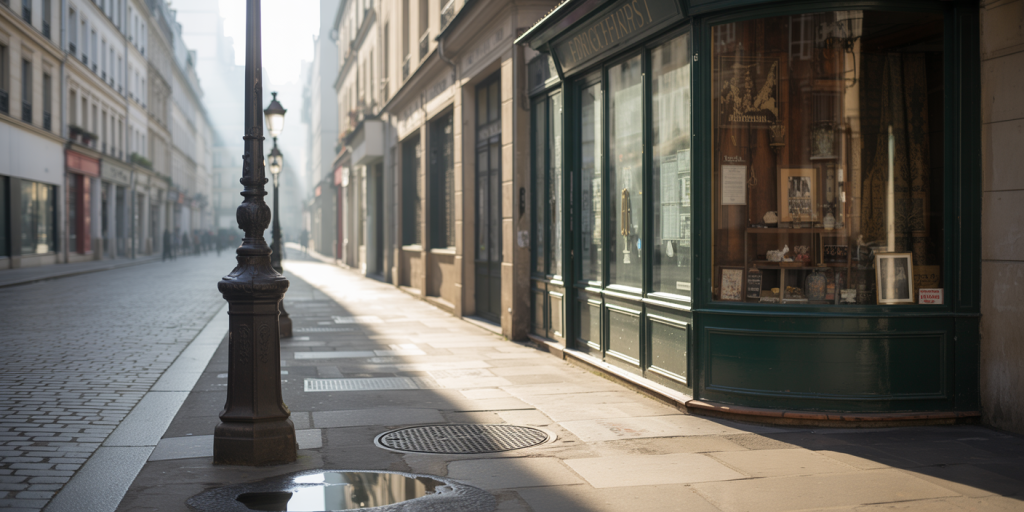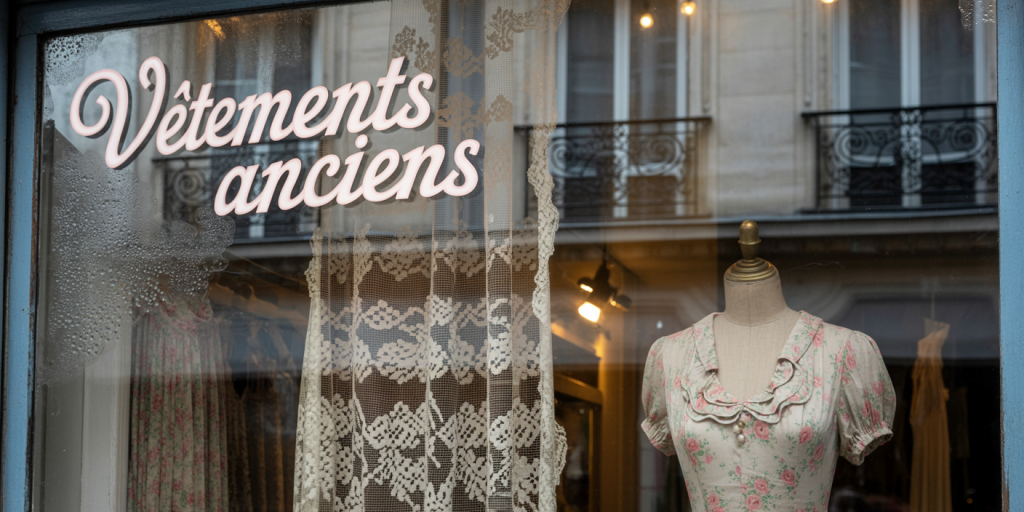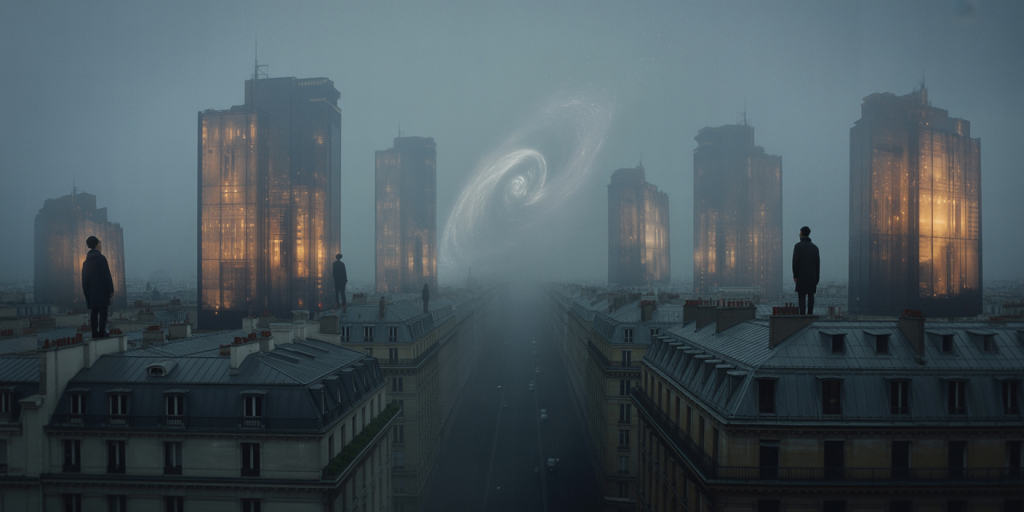Between Mirrors and Passers-by: Floating Cities in the Style of Atget
Opening Meditation
In the hour when Paris forgets itself, just before the city stretches into daylight, shadows drift like thoughts between the shutters and the cobblestones. There is no movement, yet everything pulses: the wet sheen of a storefront mirror, the echo of invisible heels brushing past gaslit lampposts, and the foggy breath of morning hesitating over the Seine. In this suspended instant, Eugène Atget captured not a city, but a soul stretched thin across time.
“Between Mirrors and Passersby” is not a single image but a procession of echoes—footsteps of the unseen, glances of the forgotten, and reflections that do not reflect but dream. Atget does not photograph architecture; he whispers with light onto glass plates, composing odes to absence. In these floating cities, nothing is quite where it seems, and every mirror opens a passage to somewhere half-remembered. The cities don’t stand—they drift, silent and haunted, like ghosts dressed in stone.

Table of Contents
- The Breath of Empty Streets
- Reflections That Lie Quietly
- Ghosts in the Shop Window
- Where the Fog Touches Iron
- A Mirror Facing a Soul
- Balconies Suspended in Time
- Stone Facades with Beating Hearts
- Shadows Draped Over Symmetry
- The Doorways That Remember You
- Dreams Etched in Dust
- The Geometry of Loneliness
- Light that Forgets to Warm
- Silhouettes in the Edge of Glass
- The Rain That Doesn’t Fall
- Veils of Silence
- Forgotten Glances on Broken Pavement
- The Stillness that Moved
- Refractions of Intimacy
- Memory Framed in Iron and Fog
- The Final Stare of a Passing Stranger
The Breath of Empty Streets
Every image in this series exhales. The streets breathe—slowly, deliberately—as if waiting for someone who just turned the corner a century ago. The emptiness is not void, but presence. It is presence dressed in absence: a sense of lives that just slipped out of frame.
Compositionally, Atget places the viewer on the threshold. We are never fully inside nor entirely outside; instead, we hover—like ghosts ourselves—between cobblestones and clouds. The perspective is human but disembodied, as if the lens inherited the memory of a passerby who once paused here and never returned.
Reflections That Lie Quietly
In Atget’s floating cities, reflections are not truth—they are poetry. The glass of windows holds not images but enigmas: a storefront mirror showing the hint of a hat, a silhouette folding into wrought iron, the vanishing trace of someone who never entered.
These mirrored surfaces act as portals, not duplications. They bend the idea of reality into something more elusive. There is always a doubling—a face without a body, a city turned inside out—suggesting that what we see is only the echo of what we forgot to notice.
Ghosts in the Shop Window
Within the windows of old Parisian shops, mannequins stand like witnesses. Their silence roars. Behind them, lace curtains dissolve into dust, and perfume bottles gather the breath of decades. They are not props but phantoms—emblems of commerce turned relics of memory.
The lighting is diffused, as if the sun itself has grown nostalgic. Soft shadows wrap themselves around the glass, blurring the division between the street and the scene behind it. This is a Paris that no longer sells; it remembers.
Where the Fog Touches Iron
Wrought iron is not simply a decorative element in these photographs. It is a line of poetry, written in steel. Balconies curl like signatures, and fences twist like sighs caught in time. When the fog rolls in, it doesn’t obscure—it wraps these elements in mystery.
Atget’s ability to capture moisture on metal, the faint sheen of dampness, reveals his tactile intuition. One can almost smell the rust, feel the chill of fog-drenched mornings. It is an art of suggestion, where even solid forms seem suspended, not quite anchored to the world.
A Mirror Facing a Soul
One of the most striking pieces in the collection features a mirror hung in a narrow alley, facing no one—and yet, it reflects everything. The city’s soul emerges here. The mirror contains not form, but feeling.
The framing is intimate. We feel the weight of stillness, the density of what is not said. The photograph is nearly monochrome, yet alive with tonal nuances. This image is a confrontation: not with the city, but with the self who looks and does not see.
Balconies Suspended in Time
Atget’s balconies appear not as extensions of buildings, but as thoughts reaching out into the fog. They are hesitant, delicate, sometimes ornate, and always isolated. No one leans on them. No flowerpots hang from their rails. They exist as punctuation marks in the air.
Their placement in the frame—often toward the top third—creates a visual tension, as if they might float away. The shadows beneath them stretch downward like memories too heavy to lift.
Stone Facades with Beating Hearts
The buildings Atget portrays are never inert. Each facade seems to possess a pulse. Cracks in the plaster form veins; shuttered windows resemble closed eyelids in sleep or mourning.
The textures are painstakingly rendered. Scratches, flakes of peeling paint, and the gritty residue of soot become topographies of time. These surfaces are emotional landscapes—walls that have witnessed generations whispering through them.

Shadows Draped Over Symmetry
Order is never sterile in Atget’s work. His symmetrical compositions breathe tension, for shadows always disrupt perfection. An archway precisely framed still houses ambiguity. A reflection slices a straight line but shivers in the puddle.
The emotional effect is subtle disquiet. The balance achieved is always precarious, like a dream that teeters on waking. Light does not merely fall—it chooses its alliances with care, revealing only what memory can tolerate.
The Doorways That Remember You
There is something sacred in how Atget frames doors. They are thresholds, yes—but also keepers. These are not doors for entering. They are for remembering: who stood here, who hesitated, who never knocked again.
Often, the doorknobs gleam faintly, touched by hundreds of forgotten hands. The stone steps worn smooth speak of repetition, of lives passing through without ever leaving. There is no grandeur here—only tenderness carved in wood and stone.
Dreams Etched in Dust
Dust becomes a material in Atget’s compositions. It blurs glass, softens light, and quiets sharpness. Dust is time visible. It layers itself not as decay, but as testimony—proof that something has lingered.
We are drawn to the way dust diffuses detail, evoking a visual hush. It creates a texture both intimate and melancholy, as though the scene were exhaling one final breath. Every surface seems wrapped in memory.
The Geometry of Loneliness
Rectangles of windowpanes, circles of lamplight, lines of gutters—these urban geometries in Atget’s vision are not merely architectural. They are diagrams of solitude. Each form defines space, but more crucially, separation.
The composition often uses leading lines to nowhere: a railing that vanishes into shadow, a corridor of trees with no visible terminus. These are not paths but propositions—questions without answers. The loneliness is not imposed; it is inherent.
Light that Forgets to Warm
Atget’s use of light is spectral. It illuminates without comforting. A shaft of morning sun across a courtyard may highlight an abandoned chair. A glimmer from a gaslamp paints only the edge of a shutter.
The light defines but does not caress. It is clinical in its neutrality, yet the resulting mood is deeply human. We feel not the light itself, but its hesitation—its withdrawal just before offering solace.
Silhouettes in the Edge of Glass
On rare occasions, figures do appear—blurred, partial, hesitant. They are never protagonists. They slip into the composition like reluctant confessions. A hand, a coat hem, a profile brushed in silver nitrate.
Their presence heightens the absence. These silhouettes are less characters than punctuation—pauses in the visual sentence. They mark what is no longer there. In this way, Atget offers a city haunted not by ghosts, but by possibility.
The Rain That Doesn’t Fall
Although we seldom see rain in these images, we feel it everywhere. Puddles, wet cobbles, slick rooftops—signs of rain recently passed or eternally anticipated. This is not meteorology—it is mood.
Rain, in Atget’s world, is a metaphor for continuity. It erases footsteps, glosses over decay, and introduces reflections that shimmer like secrets. The city under rain becomes more itself—blurred, soft-spoken, emotionally porous.
Veils of Silence
Silence in these works is not emptiness but saturation. It presses against the frame, dense and alive. Sound has no place here, yet its absence resonates: the echo of footsteps unmade, the hush before shutters open.
Technically, the silence is achieved through spatial composition. There is always distance—between objects, between tones, between the viewer and the subject. Atget’s silence is not passive; it is deliberate, a velvet curtain drawn over the noise of modernity.
Forgotten Glances on Broken Pavement
Sidewalks and streets, often overlooked, become expressive surfaces under Atget’s gaze. The cracks and patches, the uneven stones, the puddles like spilled ink—each contributes to a visual grammar of wear and history.
Here, the pavement holds memory. It recalls the weight of the workers, the lovers, the exiles. The brokenness is not disorder but biography, each flaw a sentence in the ongoing novel of the city.
The Stillness that Moved
Paradoxically, it is the lack of motion that suggests movement. A fallen leaf mid-frame, a curtain caught in wind, a cart half-turned—all imply that something just happened, or is about to.
This suspended temporality creates tension. The viewer feels like a witness who arrived a second too late, or a moment too early. The stillness becomes unbearable in its suggestion of the unseen and the unseeable.
Refractions of Intimacy
In scenes of interior glimpses—through lace curtains or half-closed blinds—Atget offers a sacred voyeurism. We are permitted intimacy not through exposure, but through discretion.
These moments feel like confessions. A vase on a windowsill. A chair pulled askew. The light falling across a made bed. They whisper of lives lived quietly, unseen yet deeply real. Atget reveals not the people, but their residue.
Memory Framed in Iron and Fog
Iron railings, streetlamps, stairwells—these are more than urban elements. They are anchors in the sea of forgetfulness. The fog softens, but the iron insists. Memory resides in this contrast.
The framing is masterful. Often, an iron gate is shot through a veil of mist, creating a dialogue between clarity and obscurity. It’s a metaphor for remembrance itself—partial, framed, always selective.
The Final Stare of a Passing Stranger
Toward the end of the series, a photograph captures a blurred figure mid-turn. The face is indistinct. The motion unclear. Yet the feeling is palpable: someone looked, briefly, into the lens—and into us.
This moment breaks the spell. We are reminded that behind every image is a human eye, and behind every street, a life. This stranger could be anyone. Perhaps, for a moment, they were us.

FAQ
Who was Eugène Atget, and why is he considered a pioneer of modern photography?
Eugène Atget (1857–1927) was a French photographer renowned for his methodical yet poetic documentation of Paris and its vanishing corners. Though he considered himself more an archivist than an artist, his sensitivity to light, shadow, and the emotional charge of space deeply influenced later surrealists and modern photographers like Berenice Abbott and Walker Evans. Atget’s work bridges the 19th-century realism and 20th-century introspection, revealing the ghostlines beneath the modern city.
What is the significance of mirrors and reflections in this body of work?
In Between Mirrors and Passersby, mirrors are not mere objects—they are metaphysical gateways. They reflect not the literal, but the longed-for; not the present, but the residual. Atget uses them to challenge the idea of visibility itself, suggesting that what we glimpse is often what is already gone. Mirrors in his compositions do not return our gaze—they absorb it.
Why are human figures so rare and vague in these photographs?
Atget’s world is one of presence-through-absence. When human figures appear, they are blurred, ephemeral, almost spectral. This was partly due to his long exposure times, but it also became a signature—emphasizing memory over action, residue over identity. The city itself becomes the protagonist, with people as whispers in its architecture.
What photographic techniques did Atget use, and how did they shape the aesthetics?
Atget used a large-format bellows camera with glass negatives and natural light. He avoided retouching, embracing imperfections as part of the medium’s authenticity. The long exposure times captured stillness and blurred motion, lending his images a dreamlike temporal ambiguity. These methods enhanced his poetic framing of a city in transition.
How does fog contribute to the mood in Atget’s photographs?
Fog, for Atget, is both veil and revelation. It diffuses edges, softens contrast, and imbues structures with melancholy. Far from concealing, it reveals what clarity often hides: mood, memory, yearning. The fog isn’t just atmospheric—it’s emotional. It wraps buildings like forgotten letters in time.
Are these photographs staged or spontaneous?
None of Atget’s works were staged. His subjects—doors, stairwells, shop windows—were encountered as-is, yet composed with care. There is no manipulation, only interpretation. This lends his images a sincerity rare in artistic documentation. His spontaneity lies not in impulse, but in instinctive reverence for the seen world.
What influence did Atget have on later movements, like Surrealism or Modernism?
Though Atget died before seeing artistic acclaim, his work deeply inspired the Surrealists, who saw in his eerie compositions a dream-logic hidden in daylight. André Breton and Man Ray both collected his photos, sensing their psychological charge. Later, modernist photographers embraced his realism not as documentation but as inner revelation.
Why does the article refer to ‘memory’ so often when discussing Atget’s images?
Memory is the invisible architecture of Atget’s Paris. The stillness of his streets, the textures of dust, the symmetry of silence—all evoke the weight of things remembered, forgotten, or misremembered. His camera doesn’t freeze moments; it excavates them. Each frame is not a document, but a reverie.
What distinguishes Atget’s view of Paris from that of other photographers?
Where others capture Paris as spectacle or postcard, Atget captures its breath. He sees the soul in its stillness, the drama in its quiet corners. His Paris is not the city of lights, but the city of echoes. Through his lens, it is not celebrated but contemplated—receding gently into the fog of emotion.
Was “Between Mirrors and Passersby” a specific collection by Atget?
The title is a poetic interpretation of his oeuvre rather than a literal series. It encapsulates the atmosphere and recurring motifs found across his urban imagery. Many of the photographs described in the article are drawn from multiple periods and themes in his career, unified here by mood and metaphor.
Final Reflections – The Echo Beneath the Shutter
No photograph in Between Mirrors and Passersby asks to be understood. They ask to be felt—quietly, like mist on the cheek or memory in a half-lit room. Atget’s Paris is not a place of arrival or direction, but of drift. It is a city untethered from chronology, floating gently between steel and silence.
Each doorway, each pane of glass, each forgotten stairwell hums with a kind of intimate abandon. He gives us the geometry of longing, the architecture of things unsaid. His art is the ghost of touch—the way an old song brushes the skin with warmth it never had, and yet you remember it.
To view these images is to become a traveler not through space, but through atmosphere. We enter through mirrors, we pass by ourselves. Atget offers no guide, only a gaze. And in returning it, perhaps we find the city within us, not as it was—but as it remembers us still.
